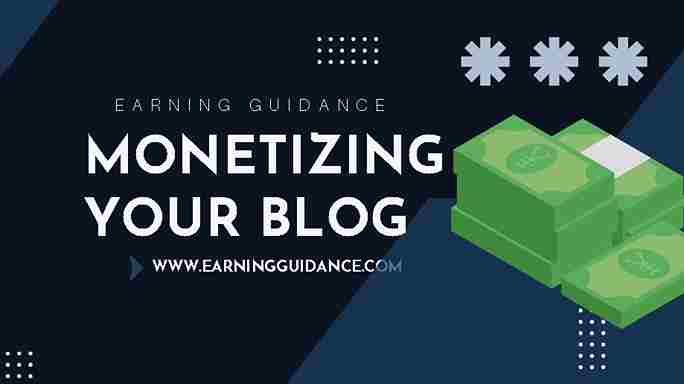Table Of Contents
- 1 10 Mistakes to Avoid as a New Blogger By Earning Guidance
- 2 Introduction
- 3 Lack of Planning and Research
- 4 Neglecting SEO
- 5 Inconsistent Posting Schedule
- 6 Poor Content Quality
- 7 Neglecting Audience Engagement
- 8 Lack of Promotion and Marketing
- 9 Ignoring Analytics and Metrics
- 10 Neglecting Blog Design and User Experience
- 11 Underestimating the Power of Networking
- 12 Neglecting Monetization Opportunities
- 13 FAQs
- 14 Conclusion
10 Mistakes to Avoid as a New Blogger By Earning Guidance
Introduction
Blogging has become a powerful platform for self-expression and communication in the digital age. Whether you’re a hobbyist or aspiring professional, starting a blog can be an exciting endeavor. However, to ensure your blogging journey is smooth and successful, it’s crucial to be aware of common mistakes that new bloggers often make. This article aims to guide you through the pitfalls and help you avoid these missteps. Let’s dive in!
Lack of Planning and Research
One of the biggest mistakes that new bloggers often make is diving into the blogging world without proper planning and research. Without a clear roadmap and understanding of your target audience and niche, your blog may struggle to find its footing. Here are some key points to consider to avoid this mistake:
- Define Your Goals and Target Audience: Before you start your blog, take the time to define your goals. What do you hope to achieve with your blog? Is it to share your expertise, build an online presence, or generate income? Additionally, identify your target audience. Who are you writing for? Understanding your goals and audience will help shape your content strategy.
- Research the Competitive Landscape: Take the time to research other blogs in your niche. Look for successful blogs and analyze their content, style, and engagement. Identify gaps and opportunities within the niche that you can leverage to make your blog stand out. This research will give you insights into what works and what doesn’t in your chosen niche.
- Find Your Unique Niche: With countless blogs out there, finding your unique niche is crucial. Determine what makes your blog different and why readers should choose you over others. It could be a unique perspective, a specific target audience, or a specialized topic within your niche. Having a niche allows you to establish yourself as an authority in a specific area.
- Develop a Content Strategy: A well-defined content strategy is essential for the success of your blog. Plan the types of content you want to create, the topics you’ll cover, and the frequency of your posts. This will help you maintain consistency and provide valuable content to your readers. Consider using an editorial calendar to organize your ideas and schedule your posts in advance.
By taking the time to plan and research before launching your blog, you’ll have a solid foundation for success. It will ensure that you’re targeting the right audience, creating valuable content, and differentiating yourself from the competition.
Building a Strong Personal Brand Through Blogging
Remember, this is just one of the common mistakes new bloggers should avoid. Let’s move on to the next section and explore another crucial aspect: Neglecting SEO.
Neglecting SEO
Neglecting search engine optimization (SEO) is a common mistake that many new bloggers make. SEO plays a vital role in driving organic traffic to your blog and increasing its visibility in search engine results. Here are some key points to consider to avoid neglecting SEO:
- Understand the Basics of SEO: Familiarize yourself with the fundamentals of SEO. Learn about keywords, meta tags, and on-page optimization techniques. Understanding how search engines work and what they look for in a well-optimized website will help you make informed decisions when creating and optimizing your blog content.
- Optimize Your Blog Posts: When creating blog posts, optimize them for relevant keywords. Conduct keyword research to identify the terms and phrases that your target audience is searching for. Incorporate these keywords naturally into your blog post titles, headings, and throughout the content. Pay attention to meta tags, such as meta descriptions and title tags, as they influence how your blog appears in search engine results.
- Build Quality Backlinks: Backlinks, which are links from other websites to your blog, are an important factor in SEO. They signal to search engines that your blog is reputable and authoritative. Focus on building high-quality backlinks from reputable websites in your niche. Guest posting, collaborating with other bloggers, and engaging in online communities are effective ways to acquire backlinks.
- Improve Site Structure and Navigation: Ensure that your blog has a clear and intuitive site structure. Organize your content into categories and use relevant keywords in your URLs. Optimize your blog’s navigation to make it easy for visitors and search engines to find and navigate through your content. A well-structured blog improves user experience and helps search engines crawl and index your pages effectively.
- Create Engaging and Shareable Content: While SEO is important, don’t forget that your primary audience is human readers. Create valuable, informative, and engaging content that resonates with your target audience. When readers find your content valuable and shareable, it can lead to increased visibility and organic backlinks, which are beneficial for SEO.
Remember to strike a balance between optimizing your blog for search engines and providing a great user experience. Neglecting SEO can result in missed opportunities to attract organic traffic and grow your blog’s audience.
Now that we’ve covered the importance of avoiding the neglect of SEO, let’s move on to the next section: Inconsistent Posting Schedule. But before we do, I’d like to provide you with some external links that you can refer to for further information on SEO:
These resources will provide you with comprehensive insights and actionable tips to enhance your understanding of SEO. Now, let’s continue with the next section: Inconsistent Posting Schedule.
Inconsistent Posting Schedule
Maintaining a consistent posting schedule is crucial for the success of your blog. Inconsistent posting can lead to a loss of readership and engagement. Here are some key points to consider to avoid an inconsistent posting schedule:
- Set Realistic Posting Goals: Determine how frequently you can realistically publish new content on your blog. Consider factors such as your available time, resources, and the complexity of your content. Setting achievable posting goals ensures that you can consistently deliver high-quality content without overwhelming yourself.
- Create an Editorial Calendar: Develop an editorial calendar to plan and organize your content in advance. This calendar will help you stay organized and ensure that you have a clear roadmap for your blog’s content. Include topics, publishing dates, and any special promotions or events you want to align your content with. By planning ahead, you can avoid last-minute scrambling and ensure a steady stream of content for your audience.
- Use Scheduling Tools: Take advantage of scheduling tools to automate the publishing process. Platforms like WordPress and Blogger allow you to schedule your posts in advance, ensuring that they go live at a specific date and time. By scheduling your posts, you can maintain a consistent posting schedule even when you’re busy or away.
- Repurpose and Update Content: If you’re struggling to create new content regularly, consider repurposing and updating your existing content. Repackage your older blog posts into different formats such as infographics, videos, or podcasts. Additionally, revisit and update your evergreen content to ensure its relevance and accuracy. This approach allows you to maintain consistency while providing fresh and valuable content to your audience.
- Communicate with Your Audience: If you anticipate a temporary disruption in your posting schedule, such as vacations or busy periods, communicate this to your audience. Inform them of the temporary change and assure them that regular content will resume soon. Open communication helps manage expectations and maintains engagement with your audience.
- The Power of Visual Content: Creating Stunning Blog Graphics
Remember, consistency is key when it comes to blogging. By establishing a realistic posting schedule and using tools and strategies to maintain it, you’ll build trust with your audience and keep them coming back for more.
Now that we’ve discussed the importance of maintaining a consistent posting schedule, let’s move on to the next section: Poor Content Quality. But before we do, I’d like to provide you with some external links that you can explore for further information on creating a consistent posting schedule:
- CoSchedule’s Editorial Calendar Template
- Buffer’s Social Media Scheduling Tool
- Hootsuite’s Social Media Planning Guide
These resources will assist you in effectively planning and scheduling your blog posts. Now, let’s continue with the next section: Poor Content Quality.
Poor Content Quality
Ensuring high-quality content is essential for attracting and retaining readers. Poor content quality can drive away your audience and hinder the growth of your blog. Here are some common mistakes to avoid to maintain the highest possible content quality:
- Insufficient Research: Failing to conduct thorough research before writing a blog post can result in inaccurate or incomplete information. Take the time to gather reliable sources, statistics, and facts to support your content. Proper research adds credibility and value to your blog posts.
- Weak Headlines and Introductions: Your headlines and introductions play a vital role in capturing readers’ attention. Weak or uninteresting headlines may discourage readers from clicking on your post, while dull introductions can fail to engage them from the start. Craft compelling headlines that evoke curiosity and create introductions that hook readers and make them eager to read further.
- Poor Writing Style: Grammatical errors, awkward sentence structures, and spelling mistakes can undermine the quality of your content. Proofread your posts thoroughly to eliminate any errors. Consider using grammar-checking tools and enlisting the help of a trusted friend or editor to ensure your writing is clear, concise, and error-free.
- Lack of Originality: Creating original and unique content is crucial to stand out in the crowded blogosphere. Avoid duplicating content from other sources or rehashing common topics without adding new perspectives or insights. Provide your readers with fresh ideas, unique experiences, and valuable knowledge that they can’t find elsewhere.
- Neglecting Formatting and Readability: Walls of text without proper formatting can be daunting and difficult to read. Break up your content into smaller paragraphs, use subheadings to organize information, and incorporate bullet points and numbered lists to enhance readability. Utilize visual elements like images, infographics, and videos to make your content visually appealing and engaging.
- Lack of Engagement: Engaging with your readers is crucial for building a loyal audience. Ignoring comments, failing to respond to questions, or not encouraging discussion can create a sense of detachment. Take the time to interact with your readers, respond to their comments, and foster a sense of community around your blog.
- Failure to Update and Refresh Content: Outdated or stale content can harm your blog’s reputation. Regularly review your older posts and update them with the latest information and insights. Consider repurposing successful content into different formats to reach new audiences and give your existing readers fresh perspectives.
Monetizing Your Blog: Proven Methods for Generating Income
Remember, high-quality content is the cornerstone of a successful blog. By avoiding these common mistakes and consistently delivering valuable, well-researched, and engaging content, you’ll establish your blog as a trusted source of information and attract a loyal following.
Now, let’s move on to the next section: Neglecting Audience Engagement. But before we do, I’d like to provide you with some external links that can further assist you in creating high-quality content:
These resources offer tools and guidance to improve your writing, optimize your content for SEO, and create visually appealing graphics. Now, let’s continue with the next section: Neglecting Audience Engagement.
Neglecting Audience Engagement
Neglecting audience engagement can hinder the growth of your blog and limit your ability to connect with your readers on a deeper level. Building a loyal and engaged audience is essential for the success of your blog. Here are some key mistakes to avoid when it comes to audience engagement:
- Ignoring Comments and Feedback: Failing to respond to comments or engage in discussions with your readers sends a message that you’re not interested in their opinions or feedback. Take the time to read and reply to comments on your blog posts, showing appreciation for their input and encouraging further interaction.
- Lack of Social Media Presence: Social media platforms offer a valuable opportunity to engage with your audience beyond your blog. Neglecting social media or not actively participating in conversations on these platforms can limit your reach and connection with your readers. Create profiles on relevant social media platforms and actively share your blog content, respond to comments, and initiate conversations.
- Inconsistent or Infrequent Email Communication: Email marketing is a powerful tool for nurturing your audience and maintaining a direct line of communication. Neglecting to build an email list or failing to send regular updates and newsletters can result in missed opportunities to engage with your readers. Develop an email marketing strategy and consistently communicate with your subscribers.
- Lack of Call-to-Action (CTA): Encouraging your readers to take action is essential for engagement. Failing to include clear and compelling CTAs in your blog posts can result in missed opportunities to interact with your audience. Incorporate relevant CTAs such as asking for comments, inviting readers to subscribe, or encouraging them to share your content.
- Not Encouraging User-Generated Content: Engaging your audience goes beyond just your own content. Actively encourage your readers to contribute their thoughts, ideas, and experiences through user-generated content. This can include guest posts, comments, testimonials, or sharing their success stories related to your blog’s niche.
- Missing Out on Community Building: Building a community around your blog is crucial for fostering engagement. Neglecting to create a sense of community by not actively engaging with your readers or providing platforms for discussion and interaction can limit the growth and impact of your blog. Consider creating a forum, hosting live Q&A sessions, or initiating discussions on social media platforms.
- Lack of Personalization: Treating your audience as a faceless mass can hinder engagement. Personalization is key to fostering a deeper connection with your readers. Address your audience directly, use their names when possible, and tailor your content to their specific needs and interests.
By avoiding these mistakes and actively engaging with your audience, you can create a thriving community of loyal readers who actively participate and share your content. Now, let’s move on to the next section: Lack of Promotion and Marketing
Now, let’s continue with the next section: Lack of Promotion and Marketing.
10 SEO Strategies for Boosting Your Blog’s Visibility
Lack of Promotion and Marketing
Neglecting promotion and marketing efforts can severely limit the visibility and growth of your blog. Even if you create high-quality content, it’s crucial to actively promote and market your blog to reach a wider audience. Here are some common mistakes to avoid when it comes to promotion and marketing:
- Underutilizing Social Media: Social media platforms provide excellent opportunities to promote your blog content and engage with your target audience. Neglecting to leverage social media or using it inconsistently can hinder your blog’s reach. Create dedicated profiles on relevant social media platforms and regularly share your blog posts, engage with your followers, and participate in relevant discussions.
- Failure to Build Relationships with Other Bloggers and Influencers: Collaborating with other bloggers and influencers in your niche can significantly expand your reach and introduce your blog to new audiences. Neglecting to build relationships with fellow bloggers or industry influencers can limit your exposure. Reach out to like-minded bloggers for guest posting opportunities, collaborations, or joint ventures to mutually benefit from each other’s audiences.
- Not Exploring Guest Posting Opportunities: Guest posting on other blogs in your niche is an effective way to reach a wider audience and establish your expertise. Neglecting guest posting opportunities can limit your exposure and prevent you from building valuable backlinks. Research and reach out to relevant blogs that accept guest posts and contribute high-quality content to expand your reach.
- Ineffective Email Marketing: Email marketing allows you to directly communicate with your audience and drive traffic to your blog. Neglecting to build an email list or failing to implement effective email marketing strategies can hinder your blog’s growth. Offer valuable incentives, such as freebies or exclusive content, to encourage readers to subscribe to your email list. Regularly send newsletters, updates, and personalized content to engage and nurture your subscribers.
- Lack of Search Engine Optimization (SEO) Knowledge: Optimizing your blog for search engines is essential for increasing organic traffic. Neglecting SEO practices, such as keyword research, optimizing meta tags, and building backlinks, can hinder your blog’s visibility in search engine results. Invest time in learning SEO techniques or consider hiring an SEO expert to optimize your blog’s performance.
- Ignoring Content Promotion Strategies: Merely publishing content on your blog is not enough. Neglecting to actively promote your blog posts through various channels can limit their reach. Utilize content promotion strategies such as social media advertising, content syndication platforms, influencer outreach, and participation in relevant online communities and forums to increase your blog’s visibility.
- Failing to Analyze and Adjust Marketing Strategies: Monitoring and analyzing the performance of your marketing efforts is crucial for identifying what works and what doesn’t. Neglecting to track key metrics, such as website traffic, click-through rates, and conversion rates, can prevent you from optimizing your marketing strategies. Use analytics tools to measure the effectiveness of your promotional efforts and make data-driven adjustments.
By avoiding these common promotion and marketing mistakes, you can significantly enhance your blog’s visibility, attract a larger audience, and drive sustained traffic. Now, let’s move on to the next section: Ignoring Analytics and Metrics. But before we do, here are a couple of external links that can provide further insights on blog promotion and marketing:
These resources offer valuable tips and strategies for promoting and marketing your blog effectively. Now, let’s continue with the next section: Ignoring Analytics and Metrics.
Ignoring Analytics and Metrics
Ignoring analytics and metrics is a common mistake that many bloggers make. Analytics provide valuable insights into the performance of your blog, helping you understand your audience, track progress, and make informed decisions to improve your strategies. Here are some key aspects to consider and avoid when it comes to analytics and metrics:
- Failure to Set Up Analytics: Neglecting to set up an analytics tool for your blog is a significant oversight. Analytics platforms like Google Analytics provide essential data on website traffic, user behavior, and conversions. Ensure you have the analytics tracking code installed on your blog to collect accurate data from the start.
- Not Tracking Key Metrics: Ignoring key metrics prevents you from understanding your blog’s performance and the effectiveness of your strategies. Some important metrics to track include:
- Website Traffic: Monitor the number of visitors, unique visitors, and pageviews to evaluate your blog’s overall reach.
- Bounce Rate: Analyze the percentage of visitors who leave your site after viewing only one page. A high bounce rate may indicate a need for improvement in content quality or user experience.
- Conversion Rate: Track the rate at which visitors take desired actions, such as subscribing to your email list or making a purchase. This helps evaluate the effectiveness of your calls-to-action and conversion strategies.
- Popular Content: Identify the most popular blog posts in terms of traffic, engagement, and shares. This information can guide you in creating similar content to meet your audience’s preferences.
- Referral Sources: Analyze where your traffic is coming from, such as search engines, social media platforms, or other websites. This insight helps you focus your promotion efforts on the most effective channels.
- Failure to Analyze Data: Collecting data is meaningless if you don’t analyze and interpret it. Regularly review your analytics reports to identify trends, patterns, and areas for improvement. Analyzing data can reveal opportunities to optimize your content, promotion strategies, and user experience.
- Not Adjusting Strategies: Ignoring analytics prevents you from making data-driven decisions and adjustments. Leverage the insights gained from analytics to refine your content, promotion, and engagement strategies. For example:
- Identify topics and formats that resonate with your audience and create more of that content.
- Optimize your website based on user behavior data to improve the user experience and reduce bounce rates.
- Focus your promotional efforts on platforms and channels that drive the most traffic and conversions.
- Test different calls-to-action and conversion strategies based on data insights.
- Overlooking Mobile Analytics: With the increasing use of mobile devices, it’s essential to track and analyze mobile-specific metrics. Monitor mobile traffic, bounce rates, and conversions to ensure your blog is optimized for mobile users.
Mastering the Art of Writing Engaging Blog Posts
Remember, data from analytics is a powerful tool that guides your decision-making and helps you refine your blogging strategies. By avoiding the mistake of ignoring analytics and metrics, you can continuously improve your blog’s performance and drive better results.
Now, let’s move on to the next section: Neglecting Blog Design and User Experience. But before we do, here are a couple of external links that provide further insights on analytics and metrics:
These resources offer in-depth information on analytics and metrics, helping you make the most of your data. Now, let’s continue with the next section: Neglecting Blog Design and User Experience.
Neglecting Blog Design and User Experience
Neglecting blog design and user experience can significantly impact the success and growth of your blog. A visually appealing and user-friendly design helps attract and retain visitors, enhances engagement, and encourages them to explore your content. Here are some key aspects to consider and avoid when it comes to blog design and user experience:
- Poor Visual Appeal: A blog with an unappealing design or cluttered layout can drive visitors away. Avoid the following design mistakes:
- Lack of Visual Hierarchy: Create a clear visual hierarchy by using headings, subheadings, and formatting to guide readers through your content.
- Excessive Ads and Pop-ups: Too many ads or intrusive pop-ups can disrupt the user experience and make your blog appear spammy. Use ads and pop-ups sparingly and consider their impact on user engagement.
- Inconsistent Fonts and Colors: Maintain consistency in your font styles and color schemes across your blog to create a cohesive and professional appearance.
- Unresponsive Design: With the increasing use of mobile devices, having a responsive design is crucial. Neglecting mobile optimization can lead to a poor user experience and high bounce rates. Ensure your blog design adapts to different screen sizes and devices.
- Difficult Navigation: Complex or confusing navigation menus can frustrate visitors and make it challenging for them to find the information they’re looking for. Keep your navigation simple, intuitive, and organized.
- Slow Page Load Times: Slow-loading pages can drive visitors away and negatively impact your search engine rankings. Optimize your blog’s performance by compressing images, using caching techniques, and choosing a reliable hosting provider.
- Lack of Readability: Make sure your blog posts are easy to read by using legible fonts, appropriate font sizes, and sufficient line spacing. Break up text with subheadings, bullet points, and paragraphs for better readability.
- Ignoring Accessibility: Accessibility is essential for ensuring that all visitors, including those with disabilities, can access and navigate your blog. Consider factors such as color contrast, alternative text for images, and keyboard navigation.
- Missing Contact and About Pages: Neglecting to include an About page and contact information can make it difficult for readers to connect with you. Create an About page that introduces yourself and your blog’s purpose, and provide clear contact information to encourage engagement.
- Lack of Social Sharing Options: Make it easy for readers to share your content by including social sharing buttons. This can help increase your blog’s visibility and attract new visitors.
By avoiding these design and user experience mistakes, you can create a visually appealing, user-friendly blog that engages and retains your audience.
Now, let’s move on to the next section: Underestimating the Power of Networking. But before we do, here are a couple of external links that provide further insights on blog design and user experience:
These resources offer valuable information and tips on blog design and user experience. Now, let’s continue with the next section: Underestimating the Power of Networking.
Underestimating the Power of Networking
Underestimating the power of networking can hinder your blogging journey and limit your growth potential. Building connections and relationships with other bloggers, industry experts, and influencers can open up numerous opportunities for collaboration, exposure, and knowledge sharing. Here’s why you shouldn’t underestimate the power of networking as a blogger:
- Knowledge Sharing and Learning: Networking allows you to connect with experienced bloggers and industry professionals who can share valuable insights, tips, and strategies. By tapping into their expertise, you can learn from their successes and avoid common pitfalls.
- Collaborative Opportunities: Networking opens doors to collaborative opportunities such as guest posting, joint ventures, and podcast interviews. Collaborating with others in your niche can help expand your audience reach, increase brand visibility, and establish your credibility.
- Exposure and Referral Traffic: Building relationships with influential bloggers and industry peers can lead to increased exposure for your blog. When they mention or link to your content, it can drive referral traffic to your blog and potentially attract new readers.
- Access to New Audiences: Through networking, you can tap into new audiences that might be interested in your content. Collaborating with influencers or participating in guest blogging can introduce your blog to their established audience, helping you expand your reach and attract targeted readers.
- Mutual Support and Promotion: Networking allows you to connect with like-minded bloggers who understand the challenges and successes of blogging. By supporting and promoting each other’s content, you can create a supportive community that helps amplify your reach and engagement.
- Industry Insights and Trends: Networking provides opportunities to stay updated with the latest industry insights and trends. Engaging with other bloggers and influencers allows you to stay connected and informed, helping you adapt your strategies and stay ahead in a rapidly evolving blogging landscape.
- Building Authority and Credibility: Associating with respected bloggers and influencers in your niche enhances your own credibility and authority. When you are seen as part of a trusted network, it boosts your reputation and makes it more likely for readers to trust and engage with your content.
Tips for Effective Networking:
- Attend blogging conferences, meetups, and industry events to meet fellow bloggers and industry professionals in person.
- Engage in online communities and forums related to your niche.
- Participate in social media discussions and engage with other bloggers’ content.
- Reach out to bloggers for collaborations, interviews, or featuring their content on your blog.
- Offer value to others by providing helpful insights, guest posts, or sharing their content.
Remember, networking is a long-term investment in your blogging journey. It requires genuine relationships, mutual support, and consistent engagement to reap the benefits.
Before we move on to the next section, here are a couple of external links related to networking in the blogging community:
These resources provide valuable insights and tips on effective networking strategies for bloggers. Now, let’s continue with the next section: Neglecting Monetization Opportunities.
Neglecting Monetization Opportunities
Neglecting monetization opportunities as a new blogger can prevent you from capitalizing on the potential to earn income from your blog. While monetization might not be the primary goal when starting out, exploring and implementing various strategies can help you generate revenue and turn your blog into a profitable venture. Here are some monetization opportunities you should not neglect:
- Affiliate Marketing: Affiliate marketing involves promoting products or services on your blog and earning a commission for every sale or referral made through your unique affiliate links. It allows you to earn passive income by recommending products or services that align with your blog’s niche and audience interests.
- Sponsored Content: Collaborating with brands and businesses to create sponsored content can be a lucrative monetization strategy. Brands pay you to write blog posts, reviews, or feature their products/services on your blog, providing exposure to their target audience.
- Advertising: Displaying advertisements on your blog can generate income through pay-per-click (PPC) or cost-per-impression (CPM) models. Google AdSense and other ad networks allow you to monetize your blog by placing ads within your content or sidebar.
- Digital Products: Creating and selling digital products, such as e-books, online courses, or exclusive content, can be a profitable monetization avenue. Leverage your expertise and offer valuable resources to your audience for a fee.
- Membership or Subscription Model: Offer premium or exclusive content to your audience through a membership or subscription model. This can include access to in-depth tutorials, premium resources, or a private community, requiring a recurring payment from subscribers.
- Freelancing or Services: If you have specialized skills or knowledge, offer freelance services related to your blog’s niche. This could include writing, consulting, design, coaching, or any other service that your audience may find valuable.
- Sponsored Social Media Posts: As your blog grows, you may have the opportunity to collaborate with brands on sponsored social media posts. Brands pay you to promote their products or services on platforms like Instagram, Twitter, or YouTube, leveraging your social media influence.
- Donations or Crowdfunding: If your audience finds value in your content, you can give them the option to support your work through donations or crowdfunding platforms like Patreon or Ko-fi. This allows your readers to contribute financially to your blog voluntarily.
- Email Marketing: Build an email list and leverage it for monetization by sending targeted offers, promoting affiliate products, or offering exclusive deals to your subscribers.
- Selling Physical Products: If your blog’s niche aligns with physical products, consider selling merchandise or branded items related to your blog, such as t-shirts, mugs, or accessories.
Remember, effective monetization requires a balance between generating income and maintaining the trust and loyalty of your audience. Be transparent about your monetization strategies and ensure that the products or services you promote align with your blog’s values and the interests of your readers.
FAQs
A. How long does it take to become a successful blogger?
Becoming a successful blogger takes time and effort. It varies from person to person, but generally, it can take several months to a year to gain traction and see significant results.
B. Can I monetize my blog from the beginning?
While it’s possible to monetize your blog early on, it’s essential to focus on building valuable content and an engaged audience first. Monetization should come later as your blog gains traction.
C. What are the best ways to grow my blog’s audience?
To grow your blog’s audience, focus on producing high-quality content, promoting it through social media and collaborations, engaging with your audience, and optimizing your website for search engines.
D. How often should I update my blog?
Consistency is key. The frequency of blog updates depends on your capacity and the expectations of your audience. Aim for a consistent posting schedule, whether it’s weekly, bi-weekly, or monthly.
E. Are there any specific legal considerations for bloggers?
Yes, there are legal considerations for bloggers, such as disclosing sponsored content, respecting copyright laws, and adhering to data protection regulations. Consult legal resources or professionals to ensure compliance.
Conclusion
Avoiding common mistakes as a new blogger is crucial for a successful journey. By planning ahead, producing quality content, engaging with your audience, and leveraging promotional strategies, you can overcome these pitfalls. Remember, blogging is a continuous learning process, so embrace the challenges, learn from your mistakes, and enjoy the rewarding experience of sharing your voice with the world.













One thought on “10 Mistakes to Avoid as a New Blogger”